- Unless Hindus re-discover their
civilization and history, decolonise it and articulate the Indic way non-stop
they will be at the receiving end.
During March 2023 violent attacks by NRI
supporters of Khalistan in USA, UK, Canada and Australia drew national
attention. During the month an Afghan Muslim introduced a bill in the
California Senate to ban caste discrimination.
This put Hindus on the defensive again
because learned within and outside India sought to blame the community for the protests
and caste bill. The government did what it thought appropriate but is failing
to change the narrative. Thereafter, R Jagannathan, Editorial Director of
Swarajyamag.com wrote Defanging Caste
and Khalistan Talking Points for our babus to change the narrative
In this article Hindu means Hindus,
Buddhist, Jain and Sikh or Indic except w.r.t. Khalistan. Short-form for
Government of India is GOI.
Two thoughts come to mind. One, well meaning Indians expect GOI to do the heavy lifting when they see the global narrative going against India. Two, Hindus have to stop seeing themselves as the sole beholders of social stability in India just because the Indian Civilization is Indic. Indian Muslims, amongst others, need to see conditions in India’s neighbourhood and thank their forefathers.
Actually, more Indians and media houses
need to work together to create an appropriate narrative. Their work must be
supported by GOI.
For the above to happen more Indians must
write articles/research papers and express unbiased views on social media. A
lot more needs to happen.
Also, Hindus should, in the name of
maintaining peace between communities, stop being apprehensive of talking about
atrocities on and discrimination against Hindus, past or present. If sections
of the media believe this is Hindutva, so be it. Read Hindu Victims of
Hate Crime And Equal
Rights for Hindus
The faith and feelings of Hindus are under constant attack, during colonial rule and even subsequently. This has demoralised them but things are changing. I wish to thank those who invented the Internet and the post-Partition generation that struggled hard to give their children education who have become today’s intellectual kshatriyas.
Importantly, Hindus must stop seeing
their civilization through Western eyes and realize that Indic faiths are not a
monolith and stuck in time. Indians must re-discover and articulate the Indic
way. Read Why Secularism
is not an Indian concept
Besides Caste and Khalistan this article
covers other points on which Hindus are maligned namely Sati, Status of Indian
women, Human rights, Dowry, Brahmin hatred and why did Buddhism vanish from
India. The intent is to provide a perspective and provoke thought, not incite. You
do not have to agree with me.
1. Khalistan
Our Sikh brother and sisters talk about killings, orchestrated by the Congress party, post Mrs Indira Gandhi’s assassination in 1984. None will talk about the killing of Hindus by Sikhs. Most Hindus rarely mention that too.
Sunil Sharan wrote The Truth of
1984 in The Times
of India, “It is estimated that between 1980 and 1984, thousands of Hindus lost their lives to Bhindranwale’s goons. Nobody ever even memorializes their lives, leave alone talks about their deaths. Those days, Delhi would shut down at sunset out of fear of Bhindranwale. I was a teenager applying to engineering college and wanted to travel to Kurukshetra to pick up the application forms. A friend of mine was accompanying me. The bus drove through Punjab. Those were the days when Bhindranwale’s thugs would stop buses, separate Sikhs from Hindus, and then mow the Hindus down.”
Till the 1980s our family prayer room had
a picture of Guru Nanak. The Khalistanis changed that.
Ajai Sahni, Executive Director,
Institute for Conflict Management & South Asia terrorism portal, wrote The Real
Butchers of Punjab in the Tribune, “These
real butchers were responsible for some of the most appalling slaughters of
innocents. Among the most egregious of these were the train massacres in which 74 persons were murdered in cold blood in January 1991, another 76 in June the same year and 52 that December; the slaughter of 38 bus passengers in July 1987; the killing of 35 at a festival gathering in March 1988; and of 33 killed in indiscriminate firing in a crowded market in 1990, among numberless other acts of carnage. About 65 per cent of all civilians killed by the Khalistanis were Sikhs, the community the terrorists claimed to be fighting for.”
“For long, Khalistani formations alleging ‘genocide’ have claimed that between 1 lakh and 2.5 lakh Sikhs were killed in the counterterrorism campaign in the state. The reality is, a total of 21,532 persons were killed between 1981 and 1995 in connection with Khalistani terror, including 8,090 categorised as terrorists; 11,696 civilians, almost all killed by the Khalistanis, but including some who lost their lives in ‘crossfire’; and 1,746 security force personnel (1,415 of the Punjab Police alone) killed by the terrorists.”
Have votaries of Khalistan apologised to the Hindu community for these killings? Esp. when “The relationship between Hindus and Sikhs has always been roti-beti
ka rishta (breaking bread in common and giving daughters in marriage), or nauh-maas da rishta (as fingernail is to the flesh).” Khushwant Singh in Outlook
29.3.1999 issue
Has GOI explained to U.S.A., Canada, U.K
how Karma works?
After all, it was Osama Bin Laden who was responsible for Sept 11 and
Khalistanis for the 1985 Air India Bombing ex Toronto. Read 2 men shot at
Gurudwara in California Scotland is rooting for independence.
Yet Hindus are told that
Sikhs are feeling alienated.
Senior Journalist
Shekhar Gupta wrote in ThePrint, “The ‘causes’ of the current anger and alienation are broadly four: sectarian deras (let’s say seminaries-cum-permanent congregations) as an existential threat to Sikhism, the continued incarceration of ‘Bandi Singhs’ (imprisoned Sikhs, as in the nine convicted on terror and assassination charges and held on long jail sentences). Third, that those guilty of sacrilege at Sikh shrines and for alleged desecration haven’t been caught or punished. And the fourth is a rhetorical one, that if the BJP and RSS say they’re building a Hindu Rashtra, what’s wrong with a Sikh Rashtra?”
Instead of saying that Deras are a threat to Sikhism, ask Why Dera Sacha
Sauda draws followers I wrote in 2017, “The Green Revolution of the late 1960s benefited Jaats the most as they were the dominant agricultural caste. In the prosperity that followed, the backward classes and poor were left out. To add to their woes was the insecurities caused by the extremely violent Khalistan movement of the 1980s. Deras existed earlier too, but the external environment increased the insecurity. The need for a support system and to be part of a larger community was felt. It is this vacuum that deras like Sacha Sauda filled. They made the poor feel secure, cared for, loved, provided a support system and gave them dignity.” Caste divisions
in Sikh Panth cease to exist in Deras.
Western concepts like nation (Rashtra) encourage concept of Sikh Rashtra. Read What is Hindu
Rashtra?
How long can a post 1870 British creation,
Sikhism, sustain? It was bound to face identity issues sooner or later. Read Is Modern day
Sikhism a colonial construct? And How British
divided Punjab into Hindu and Sikh
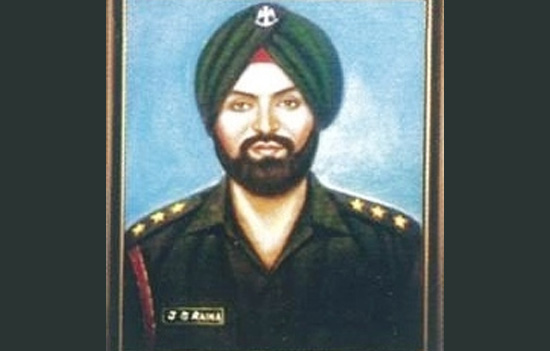 Col Jasbir Singh Raina. As you might know Raina is a Kashmiri Pandit surname.
Col Jasbir Singh Raina. As you might know Raina is a Kashmiri Pandit surname.
Those Sikhs who criticise Brahmins must know about the existence of Brahmin Sikhs. Here is an incomplete list of Brahmin Sikh clans: “Rishi, Sasan, Kala, Kalia, Chibber, Dutt, Rissam, Sudan, Vasudev, Issar, Dutta, Bhardwaj, Reen, Bali, Devgan, Ramdev, Raina.” Col Jasbir Singh
Raina received a Ashoka Chakra. Read Caste in Sikhs
Sikhs are considered Hindus under the
Income-Tax Act 1961 but minority for government schemes! Read Tax laws should
be the same for all citizens
It is for Hindus to place these facts
before the world.
The caste bit has three parts namely
Manusmriti, Who is a Dalit and Caste.
2. Manusmriti
Manusmriti is criticised like few other
sastras. Author Nanditha Krishna
wrote in Open
Magazine, “Manu’s “memories” are a record of the social life and ideas of his times, and probably did not affect the collective life of the people. Each era has its smriti and it is ridiculous to quote the belief and lifestyles of people who lived 1,600-1,800 years ago as authoritative laws today.”
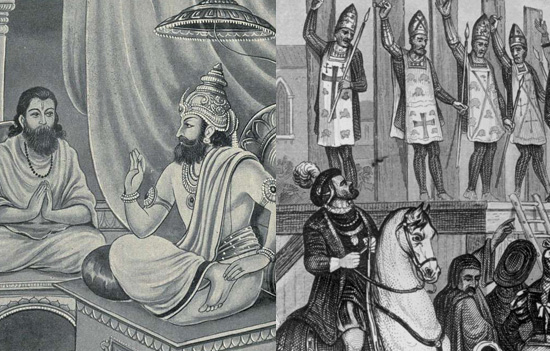
Dr Subhasis Chattopadhya compares
how Indians
treat writings of Manusmriti vs. history
of the Roman Inquisition (less than five hundred
years ago). Should not there be a level playing field?
Moreover, no scripture or shastra is
uniformly practiced across India because diversity is intrinsic to Sanatana
Dharma! So to cherry pick the Manusmriti to hit out at our Dharma is incorrect
to say the least.
3. Who is a Dalit?
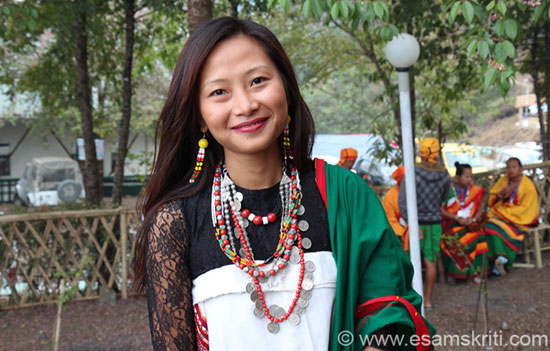 She belongs to Kachari tribe, Nagaland. 2014.
She belongs to Kachari tribe, Nagaland. 2014.
Just like the words ‘South Asia’ came into prominence in the 1970’s so did the word Dalit come into prominence since the 1990’s. There are national commissions for scheduled castes and backward classes but nowhere is the word Dalit used. The word finds no mention in the Indian Constitution. Today it means
Scheduled Castes and Scheduled Tribes. Not all Dalits are untouchables.
The nomenclature used to describe the backward classes keeps changing. In the 1890s they were called depressed classes. In the early 1930's, Mahatma Gandhi named them Harijans. The Government of India Act, 1935 introduced the term Scheduled Caste (SC) while Scheduled Tribe (ST) came into being after the Constitution was adopted.
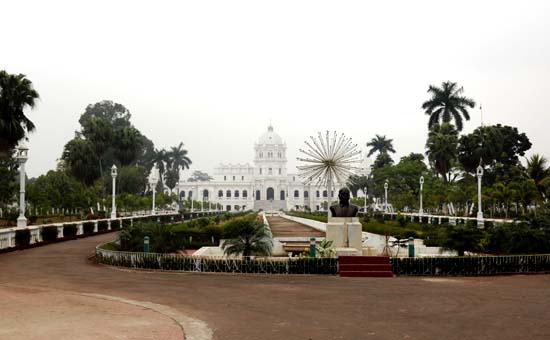 Ujjayanta Palace Agartala has a bust of Ambedkar
because its former rulers are now considered ST.
Ujjayanta Palace Agartala has a bust of Ambedkar
because its former rulers are now considered ST.
Did you know that ace music director Rahul Dev Burman belonged to the
Royal Family of Tripura, now considered ST. A bust of Ambedkar is placed at the
palace entrance to show ST status of former rulers. To see album Tribes of Tripura Museum
Founder
of political party Tipra Motha Pradyot
Deb Barma (Tripuri tribe) is a member of the royal family.
In Rajasthan, the Meena community ruled parts of Rajasthan before the
Rajputs but are a scheduled tribe today. Read
History of Meenas
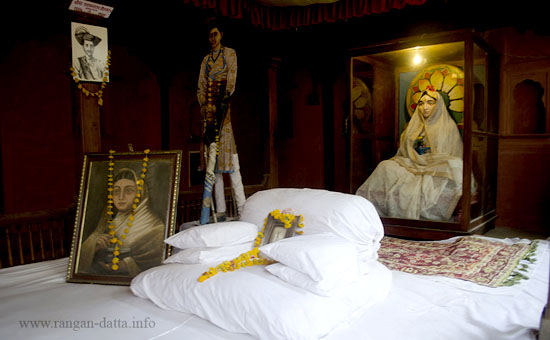 Ahilyabai Holkar Palace, Maheshwar.
Ahilyabai Holkar Palace, Maheshwar.
In Maharashtra, the Dhangar or shephered community to which belonged
the great queen Ahilyabai Holkar want to be declared a ST.
Due to reservations in government jobs, there is a race to be declared a SC or ST. Come elections numerically strong groups negotiate with the government – want our votes than declare us as SC or ST for e.g. Hattees were recently granted ST status before the 2022 assembly elections in Himachal. Another example
in Uttar Pradesh where
OBC declared as ST
Author, ex-British Council Scholar and
Spiritualist Dr Satish Kapoor wrote in Hinduism:
The Faith Eternal that spirituality is not confined to higher castes or
classes or gender. Veda Vyasa was born to a fisherwoman, Tiruvalluvar to a
weaver. Tirupann, the Alvar saint, was panar, an untouchable etc. Pg. 71 Many
saints of medieval Maharashtra came from the lower strata of society. Goraba
(1236-1317) was a potter, Namdeva (1270-1350) a tailor, Tukaram (1650) a
low-caste peasant. Ramanujacharya (1017-1137), founder of one of five major
Vaisnava schools, initiated non-Brahmins for e.g. Ramananda who taught the
fundamentals of Bhakti to Ravidasa, a cobbler. Mira Bai (1498-1557) Rajput
Queen was a follower of Sant Ravidasa Pg. 72 whose followers are today’s chamar community (of Ramdasai Sikhs), a Scheduled caste in Punjab.
Indic faiths are not a one book faith that promotes uniformity. India is diverse, so foreigners try to straightjacket its people into well defined compartments.
4. CASTE (includes benefits of caste system and Indic meaning of European word caste)
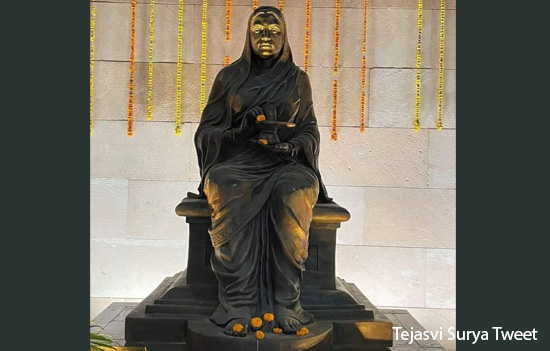 Queen Ahilyabai Holkar statue outside Kashi Vishwanath, a temple she made. Her shepherd community want to be declared a ST now. Pic courtesy Tejasvi Surya tweet.
Queen Ahilyabai Holkar statue outside Kashi Vishwanath, a temple she made. Her shepherd community want to be declared a ST now. Pic courtesy Tejasvi Surya tweet.
A bill seeking to explicitly ban
caste discrimination was introduced in the California Senate by Senator Aisha
Wahab, the first Muslim and Afghan American elected to
the state legislature. What is her understanding of the European word caste and
Bharatiya Samaj? Has she written about education of women in Afghanistan?
Whilst many criticise the caste system they will rarely write
about division of sub-continent Muslims into Ashraf (high-born), Ajlaf (low-born)
and Arzal (meaning degraded, are equivalent to untouchables). Read Empowerment of Pasmanda Muslims is a must
Let us accept that caste discrimination exists but it is
continuously falling due to reform movements and affirmative action.
Yet India is better off than others. We did not have
thirty year wars like between Christians and Protestants did in Europe or Shia
Sunnis like we see today. India is home to Shias, Sunnis and Ahmediyas who are
not treated as Muslims in Pakistan. Our President is a woman and member of the
Vanvasi Samaj. India did not have slavery like in Europe and America or
equivalent of the horrible Roman Inquisition In 2020, 45,222 people died from gun-related injuries in the
U.S., according to the Centers for Disease Control and Prevention. Local populations have not vanished like the Red Indians in the U.S. or the aboriginal tribes of Australia.
The word ‘caste’ is of Spanish or Portuguese origin and fails to capture the meaning of the Indian term, jati, which more properly translated as “community.” Jati in traditional India
promoted and preserved diversity and multiculturalism by allotting every jati a
particular space and role in society so that no jati would be appropriated or
dominated by another. Moreover, the jati system was integral to the survival of
the Indian nation.
Noted Gandhian Dharampal wrote in Rediscovering India, “For the British, as perhaps for some others before them, caste has been a great obstacle, in fact, an unmitigated evil not because the British believed in casteless-ness or subscribed to a non-hierarchical system but because it stood in the way of their breaking Indian society, hindered the process of atomisation, and made the task of conquest and governance more difficult.”
Dharampalji went through British and Indian
archives to reproduce reports of surveys undertaken by the British in Bengal,
Punjab and Madras Presidency (1800-1830) in his book The
Beautiful Tree: Indigenous Indian Education in the 18th century According to the collectors’ reports reviewed by Governor Sir Thomas Munro on 10 March 1826, of the 30,211 male school students in Madras Presidency, 20 percent were Brahmins and Chettris, 9 percent were Vaishyas, 50 percent were Shudras, and 6 percent were Muslims. Others constituted 15 percent. Read excerpts here
These percentages indicate that Shudras
comprised the majority of students and scholars in these regions.
“In the 10th century, the castes were comparatively fluid. But then the fundamental values of Dharmasastras were changed to provide defensive ramparts in order to present a solid front to an aggressive alien culture and religion.” History and Culture of Indian People Volume 5 Post foreign
invasions the caste system became rigid.
That is probably why Swami Vivekananda said, “It is owing to caste that 300 million people can find a piece of bread to eat. It is an imperfect institution no doubt. But if it had not been for caste, you would have had no Sanskrit books to study. This caste made walls, around which all sorts of invasions rolled and surged but found it impossible to breakthrough.”
However, the Varna system degenerated, over time. Note that Abbe J.A. Dubois, a Christian missionary of eminence, who stayed in India from 1792 to 1823 wrote thus, “This plan of dividing the people of India into castes is not confined to the law givers of India.” Pg. 66 J Sai Deepak wrote in India that is Bharat
How and why do the backward classes find
themselves in the situation they are today?
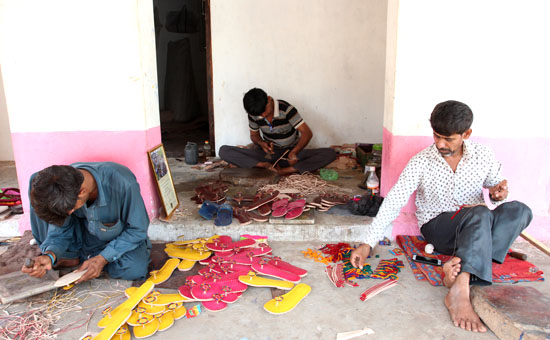 Devabhai makes footwear in a Kutch, Gujarat village & sells it to shops in Bhuj.
Devabhai makes footwear in a Kutch, Gujarat village & sells it to shops in Bhuj.
Before British rule, traditionally,
education institutions were funded by revenue contributions made by the
community and state. About one-third of the total revenue (from agriculture and
sea ports) was assigned for social and cultural infrastructure (including
education).
This system stayed mainly intact through
all previous political turmoils. The British, however, increased the quantum of
land revenue and adversely changed the terms of payment for the community. They
centralised collection of revenue, leaving hardly any revenue to pay for social
and cultural infrastructure.
Further, the means of the manufacturing classes (small-scale enterprises or SMEs in today's parlance) were greatly diminished by the introduction of European goods. Craftsmen, especially those engaged in the making of cloth, manufacture, mining of metals and construction work, were reduced to a state of homelessness.
Sapped of funds, education institutions
and manufacturing classes became history, leading to grave consequences.
It appears that the "backward" status they are struggling against is some ancient phenomenon. In reality, however, their cultural and economic backwardness (as distinct from their ritualistic status on specific occasions) arose post 1800. What backward caste movements are attempting to achieve is a reversal of the effects of the British policy, and restoration of the position, status, and rights of these peoples to those that existed prior to 1800. Read
Were Backward Classes always suppressed in India
So
deep has this theory of centuries of suppression got ingrained in our minds
that the law was compelled to provide safeguards.
1. Caste based Reservations. According to Article 334, reservations of seats and special representation are to cease after 60 years from the commencement of the Constitution i.e. by 2010. We are in 2023 and reservations continue. Read Data does not show universal backwardness of SC/ST/OBC
2.
R Jagannathan wrote
in Swarajyamag, “The other law is the SC/ST (Prevention of Atrocities) Act, where anyone accused of using a slur against Dalits or tribals has to be compulsorily arrested. Accusation is enough. It may go against basic norms of fairness, but this is the extraordinary level of social commitment to eliminate caste-based prejudices in India.”
Benefits of Caste System
1.
Well known author and former head of Proctor and Gamble India Gurcharan
Das said in Mint, “My own politically incorrect answer is that we had in India the good fortune of having merchant castes, trading communities. If you institute economic reforms in a society where people know how to conserve capital… If you have communities in whose DNA is that… it is a genetic advantage.” Source He also wrote, “Joel Kotkin demonstrates these strengths in the case of Palanpur Jains, who have used their castes and family networks in wresting half the global markets for uncut diamonds from the Jews.”
2. Columnist Aakar Patel
wrote in the Mint that the current
situation in Pakistan is because of an imbalance in caste. The situation arose
because there is no mercantile caste in Punjab after the Khatri-Arora combine
migrated to India in 1947. Source
3. Former Prof of Finance at IIM Bangalore, Dr R Vaidyanathan wrote in Caste as social capital, “The World Bank suggests that the remarkable growth of Tirupur (Tamil Nadu) is due to the coordinated efforts of Gounders many of them not even matriculates. The needed capital was raised within the Gounder community, a caste relegated to the land-based activities, relying on community and family network. Those with capital in the Gounder community transfer it to others in the community through long-established informal credit institutions and rotating savings and credit associations. These networks were viewed as more reliable in transmitting information and enforcing contracts than the banking and legal systems that offered weak protection of creditor rights.” Source Caste as social
capital
Read 1. When caste was not a bad word
2. Impact of Census
1881 by Dharampalji
3. Vedas and other
scriptures on Caste
4. Why
we cannot be so one-dimensional on caste
5. The
Truth about Caste
How many articles are published in the Indian media
of the genocide of local Red Indian Communities by White immigrants or deaths
due to Gun Culture?
We need to be equally focussed on the world
around us as with India.
5. Underplaying killings of
Kashmiri Hindus 1990
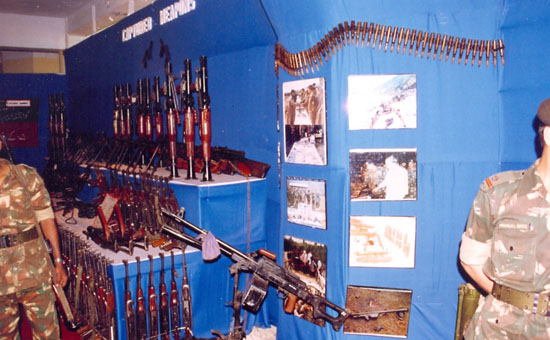 Arms seized from Kashmiri Militants, Indian Army exhibition, 1998.
Arms seized from Kashmiri Militants, Indian Army exhibition, 1998.
Till the release of Vivek Agnihotri’s The Kashmir Files doubts existed about
the massacre of Kashmiri Hindus.
According to author and social worker Khemlata Wakhlu, “Schools were targetted and set ablaze. So was the school run by Rupa Devi Sharda Peeth Trust. With the burning of the school, some of the world's rarest books and manuscripts - in Pali, Persian, Hindi, Urdu and English all went up in smoke! The greatest treasure in Kashmir - the ideas and words of wise and erudite seekers over the ages - which had been kept in the premises of the school, were gone.” Pg 292 A Kashmiri
Century Read How many killed
in Terrorism and Insurgency (includes northeast)
We now cover Indic view on Sati, status
of Indian Women, Dowry, Human Rights, and Brahmin hatred.
6. SATI
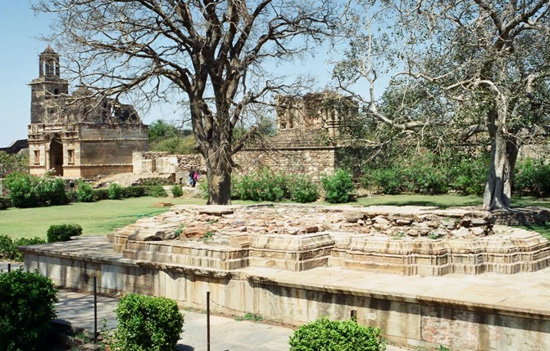 Place in Chittorgarh Fort where Jauhar was committed.
Place in Chittorgarh Fort where Jauhar was committed.
Sati tradition existed in North India (rarely
heard in South) and caught popular imagination subsequent to foreign invasions
starting the 10th century.
Ill-treatment of women post victory in
war and their abduction was unknown to Indians because of the high regard
Kshatriyas had for the chastity of women. The wars in Central Asia, on the other
hand, were grim struggles for survival, destruction of their enemies and
appropriating their womenfolk. No code existed. The History and Culture of the Indian People Volume 5
Since Indians are unaware of the Hindu
rules of war, they are unable to explain why Sati was not so prevalent prior to
the 10th century. Read War and
Non-violence in the Holy Gita
Unless
Hindus know what distinguishes their civilization from others they will be at
the receiving end. Read
Question and
Answers Indian Civilization Our knowing the truth enables us to give a appropriate reply.
7. Human Rights
Former foreign secretary Kanwal Sibal
wrote Human Rights is
a Western Policy Tool in the Economic Times, “Human
rights as a concept, with philosophical and political roots in the French and
American Revolutions, was inscribed by the West on the international agenda by
establishing the UN Human Rights Commission in 1946 and in 1948 by the adoption
of a Universal Declaration of Human Rights (UDHR) by the UN General Assembly, a
document drafted under Western superintendence. This emphasis on human rights encompassing life, liberty, equality, freedom of
speech, movement, thought, opinion, and religion was
ironic when most Asian and African countries were and remained under colonial
rule for years after UDHR and were denied all these rights and freedoms by the West.”
The Indian equivalent of rights is
Dharma. Read Human Rights in
Sanatana Dharma
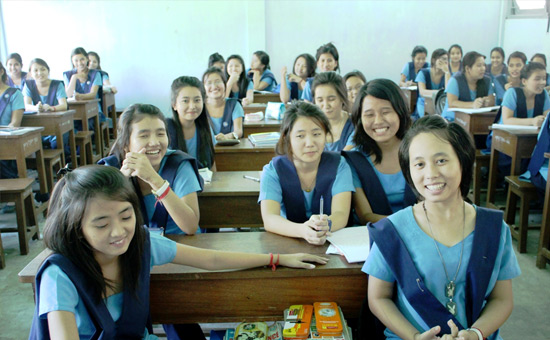 Students at Vivekanand Kendra School, Jardin near Along, Arunachal Pradesh. 2013.
Students at Vivekanand Kendra School, Jardin near Along, Arunachal Pradesh. 2013.
8. Dowry
Dowry is associated with Hindus. Try
telling critics that the islands of Mumbai were given in dowry by the Portuguese to
the British around 1662 (not that I support dowry
in its present form). Surely, this tradition existed in Europe too.
Read How the British
created the Dowry System in Punjab In this Times of India interview author Veena
Talwar states that dowry was a result of one of the many socio-economic changes
brought about the British. Read Indian
government will not be different from the British if Hindus are not allowed to
manage their temples
9. Brahmin Hatred
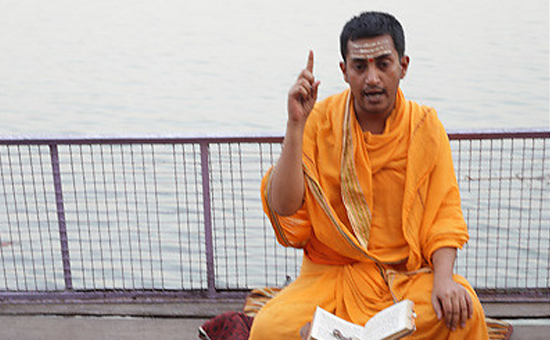
Like other human beings, including myself, Brahmins are not perfect and have faults. I am not saying this because my wife is a Brahmin. It is worth noting that Ambedkar’s Brahmin teacher took such a liking to him that he changed his surname from Ambavedekar to his own in the school’s records. Ref Dr.
AMBEDKAR Life and Mission by Dhananjay Keer . Read by Dr Satish K Kapoor Contribution of
Brahmins to Indian Society and Culture
10. Status of Women
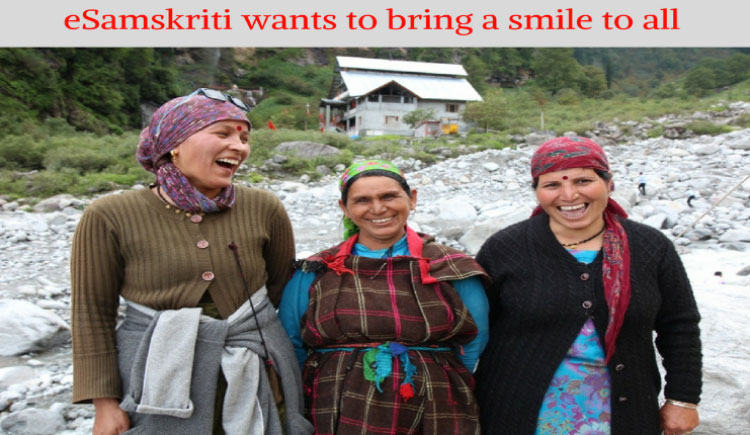 Himachali Women, Manali. 2016.
Himachali Women, Manali. 2016.
The West will not talk about status of
women in their countries earlier or today.
A E Altekar wrote in The Position of Women in the Hindu
Civilization, “The British Parliament granted franchise to its women in 1918. Down to 1850 A.D. in England, a woman could not take a walk, much less a journey, alone, nor could she ask a fellow worker to visit her, unless the worker was a girl. When two ladies spoke at a meeting convened for the purpose of supporting a women’s cause in Parliament, a Member of Parliament said “Two ladies have disgraced themselves for speaking in public”. When the House of Commons was built in 1844, it was great difficulty that a Ladies Gallery was sanctioned.”
Swami Vivekananda wrote, “You will find Maitreyi, Gargi and other ladies of revered memory have taken the places of the Rishis through their skills in discussing the Brahman. The mother is the ideal of Indian womanhood. And even God is conceived as mother. In a western home it is the wife who rules but in an Indian home it is the mother who rules.”
Read Five Elemental
Women
Unsung Women
Warriors of India
Why Ahilyabai
Holkar was a great Woman
Tarabai, the
Maratha Warrior Queen
Rani Abakka, who
defeated the Portuguese at sea
Women Gurus in
Hinduism
Yashovati, the
First Queen of Kashmir
The Incredible
Women of modern day Bharat
Boxer Nikhat
Zareen wins second gold
Nitu Ghanghas and Saweety Boora win gold at Women's Boxing World Championships
Yes, the status of women can be better. Note what Amrit Dhillion
wrote
in Times of India, “The per capita figures for rape for 2010 (nothing more recent is available on the net) are: India – 1.8 (per 1,00,000 population); Germany – 9.4; the UK – 17; Norway – 19.2; the US – 27.4. When UK figures reported a 20% rise for rape in London, there was no BBC World bulletin running a headline story.”
11. Hindus must not talk
about atrocities by Invaders
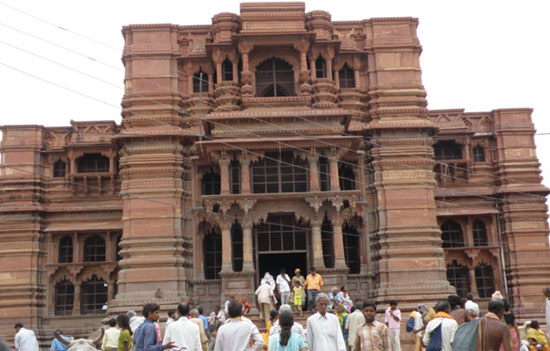 Govind Temple Vrindavan was originally 7 storey, destroyed by Aurangzeb, built by Raja Mansingh in 1590.
Govind Temple Vrindavan was originally 7 storey, destroyed by Aurangzeb, built by Raja Mansingh in 1590.
Any such talk will lead to social unrest
is what people believe. Here are five articles written by a Pakistani retired
fauji.
Sacking the
Sub-continent Mahmud Ghazni
Sacking the
Sub-continent Taimur
Sacking the
Sub-continent Nadir Shah
Sacking the
Sub-continent Abdali
The British
plunder of Bengal
History must be known and shared not
with the intent of taking revenge though.
12. Buddhism vanish from
India
Many blame Hindus for Buddhism’s absence from India. Dr B R Ambedkar said, “Buddhism in its material form had disappeared. I agree. But as a spiritual force it still exists.”
At the Parliament of Religions Swami
Vivekananda said that Buddhism is the fulfilment of Hinduism. If Jainism
continues to exist and prosper in India for centuries there must be serious
reasons for Buddhism to vanish. My article gives 9 reasons why
Buddhism vanished from India
Indians across the world and Indian media houses along
with the GOI have to work together to counter the anti-India narrative by
fellow Indians and foreigners.
LOVE and PEACE.